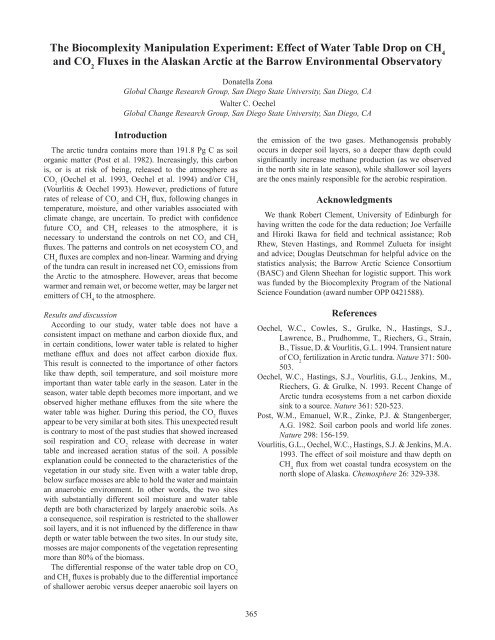Ninth International Conference on Permafrost ... - IARC Research
Ninth International Conference on Permafrost ... - IARC Research
Ninth International Conference on Permafrost ... - IARC Research
Create successful ePaper yourself
Turn your PDF publications into a flip-book with our unique Google optimized e-Paper software.
The Biocomplexity Manipulati<strong>on</strong> Experiment: Effect of Water Table Drop <strong>on</strong> CH 4and CO 2Fluxes in the Alaskan Arctic at the Barrow Envir<strong>on</strong>mental ObservatoryD<strong>on</strong>atella Z<strong>on</strong>aGlobal Change <strong>Research</strong> Group, San Diego State University, San Diego, CAWalter C. OechelGlobal Change <strong>Research</strong> Group, San Diego State University, San Diego, CAIntroducti<strong>on</strong>The arctic tundra c<strong>on</strong>tains more than 191.8 Pg C as soilorganic matter (Post et al. 1982). Increasingly, this carb<strong>on</strong>is, or is at risk of being, released to the atmosphere asCO 2(Oechel et al. 1993, Oechel et al. 1994) and/or CH 4(Vourlitis & Oechel 1993). However, predicti<strong>on</strong>s of futurerates of release of CO 2and CH 4flux, following changes intemperature, moisture, and other variables associated withclimate change, are uncertain. To predict with c<strong>on</strong>fidencefuture CO 2and CH 4releases to the atmosphere, it isnecessary to understand the c<strong>on</strong>trols <strong>on</strong> net CO 2and CH 4fluxes. The patterns and c<strong>on</strong>trols <strong>on</strong> net ecosystem CO 2andCH 4fluxes are complex and n<strong>on</strong>-linear. Warming and dryingof the tundra can result in increased net CO 2emissi<strong>on</strong>s fromthe Arctic to the atmosphere. However, areas that becomewarmer and remain wet, or become wetter, may be larger netemitters of CH 4to the atmosphere.Results and discussi<strong>on</strong>According to our study, water table does not have ac<strong>on</strong>sistent impact <strong>on</strong> methane and carb<strong>on</strong> dioxide flux, andin certain c<strong>on</strong>diti<strong>on</strong>s, lower water table is related to highermethane efflux and does not affect carb<strong>on</strong> dioxide flux.This result is c<strong>on</strong>nected to the importance of other factorslike thaw depth, soil temperature, and soil moisture moreimportant than water table early in the seas<strong>on</strong>. Later in theseas<strong>on</strong>, water table depth becomes more important, and weobserved higher methane effluxes from the site where thewater table was higher. During this period, the CO 2fluxesappear to be very similar at both sites. This unexpected resultis c<strong>on</strong>trary to most of the past studies that showed increasedsoil respirati<strong>on</strong> and CO 2release with decrease in watertable and increased aerati<strong>on</strong> status of the soil. A possibleexplanati<strong>on</strong> could be c<strong>on</strong>nected to the characteristics of thevegetati<strong>on</strong> in our study site. Even with a water table drop,below surface mosses are able to hold the water and maintainan anaerobic envir<strong>on</strong>ment. In other words, the two siteswith substantially different soil moisture and water tabledepth are both characterized by largely anaerobic soils. Asa c<strong>on</strong>sequence, soil respirati<strong>on</strong> is restricted to the shallowersoil layers, and it is not influenced by the difference in thawdepth or water table between the two sites. In our study site,mosses are major comp<strong>on</strong>ents of the vegetati<strong>on</strong> representingmore than 80% of the biomass.The differential resp<strong>on</strong>se of the water table drop <strong>on</strong> CO 2and CH 4fluxes is probably due to the differential importanceof shallower aerobic versus deeper anaerobic soil layers <strong>on</strong>the emissi<strong>on</strong> of the two gases. Methanogensis probablyoccurs in deeper soil layers, so a deeper thaw depth couldsignificantly increase methane producti<strong>on</strong> (as we observedin the north site in late seas<strong>on</strong>), while shallower soil layersare the <strong>on</strong>es mainly resp<strong>on</strong>sible for the aerobic respirati<strong>on</strong>.AcknowledgmentsWe thank Robert Clement, University of Edinburgh forhaving written the code for the data reducti<strong>on</strong>; Joe Verfailleand Hiroki Ikawa for field and technical assistance; RobRhew, Steven Hastings, and Rommel Zulueta for insightand advice; Douglas Deutschman for helpful advice <strong>on</strong> thestatistics analysis; the Barrow Arctic Science C<strong>on</strong>sortium(BASC) and Glenn Sheehan for logistic support. This workwas funded by the Biocomplexity Program of the Nati<strong>on</strong>alScience Foundati<strong>on</strong> (award number OPP 0421588).ReferencesOechel, W.C., Cowles, S., Grulke, N., Hastings, S.J.,Lawrence, B., Prudhomme, T., Riechers, G., Strain,B., Tissue, D. & Vourlitis, G.L. 1994. Transient natureof CO 2fertilizati<strong>on</strong> in Arctic tundra. Nature 371: 500-503.Oechel, W.C., Hastings, S.J., Vourlitis, G.L., Jenkins, M.,Riechers, G. & Grulke, N. 1993. Recent Change ofArctic tundra ecosystems from a net carb<strong>on</strong> dioxidesink to a source. Nature 361: 520-523.Post, W.M., Emanuel, W.R., Zinke, P.J. & Stangenberger,A.G. 1982. Soil carb<strong>on</strong> pools and world life z<strong>on</strong>es.Nature 298: 156-159.Vourlitis, G.L., Oechel, W.C., Hastings, S.J. & Jenkins, M.A.1993. The effect of soil moisture and thaw depth <strong>on</strong>CH 4flux from wet coastal tundra ecosystem <strong>on</strong> thenorth slope of Alaska. Chemosphere 26: 329-338.365
















